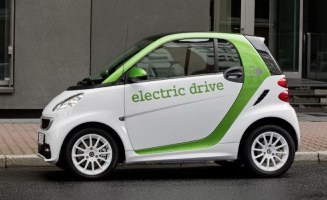CarTest! Expert car reviews and advice | home
CarTest! Expert car reviews and advice | CarTest Contents | New Car Reviews | Used Car Reviews | What is your car worth? | Automotive NewsBriefs | Award-Winning Models | Find the Best Vehicle | Automotive Advice | Save on Gas | Driving Tips & Maintenance Advice | Safety Research & Insurance Tips | Tire Advice | Road Trips | Auto Racing | Classics & Collectibles | Newsletter | About Us | SEARCH CarTest!

©CarTest.ca. All rights reserved.
ECO-RUN FOCUSES ON FUEL ECONOMY
Exercise proves official fuel-consumption figures can be achieved in real-world driving
AJAC Eco-Run demonstrates merits of fuel-saving technologies.
The second annual AJAC Eco-Run, conducted recently by the Automobile Journalists Association of Canada (AJAC), produced some eye-opening results with respect to the relative merits of different fuel-saving technologies and the effect of driving style on fuel economy.
The 2013 Eco-Run, which began in Ottawa and ended in Montreal, was not intended to be a competition among vehicles but a demonstration of the broad range of technologies currently available to help consumers reduce their fuel consumption and costs. The top two rated cars for fuel efficiency are shown here -- the 2013 Smart fortwo electric drive, and the 2013 Ford Focus Electric.
The results of the exercise support a number of important observations and conclusions:
o First, and perhaps most important, when drivers deliberately apply fuel-efficient driving techniques, as the journalists taking part in this exercise did, they can achieve some remarkably low fuel-consumption figures.
o The overall average fuel-consumption for the 22 vehicles in the Eco-Run was just 5.27 L/100 km.
 Significantly, that figure is below the average combined official fuel-consumption figures published in Natural Resources Canada's Energuide for the same vehicles.
Significantly, that figure is below the average combined official fuel-consumption figures published in Natural Resources Canada's Energuide for the same vehicles. The majority of the individual vehicles also bettered their official ratings, proving that they are in fact attainable in the real world when the vehicles are driven in a fuel-efficient manner.
o Perhaps surprisingly, that average also bettered the government's proposed fleet-average fuel-consumption target for 2025 (approximately 5.6 L/100 km).
While the group of vehicles in the Eco-Run does not represent the same distribution as that of the total vehicle population, the result is encouraging nonetheless, demonstrating that the target is potentially achievable with a broad mix of vehicle types.
o It is also important to note that these results, in most respects, equal or better the official fuel-consumption figures published in Natural Resources Canada's Energuide, proving that they are in fact attainable in the real world.
The 22 vehicles in the Eco-Run, provided by their manufacturers, encompassed a wide range of fuel-efficient technologies and powerplants, from battery-electric through plug-in and conventional hybrids, to advanced gasoline and diesel engines.
They ranged in size and type from subcompact through compact cars to a full-size SUV and a pickup truck.
 While no statistically valid conclusions can be drawn from the results in terms of car-to-car comparisons, several trends are apparent with respect to technologies:
While no statistically valid conclusions can be drawn from the results in terms of car-to-car comparisons, several trends are apparent with respect to technologies:o On a pure energy-efficiency basis, battery-electric vehicles (EVs) are by far the most efficient in both city and highway operation - for those whose lifestyle can accommodate the limited range and long recharge times inherent in EV use.
o Plug-in hybrids were the next-most-efficient as a group, achieving significantly better fuel economy than conventional hybrids in city driving, where they were able to operate in electric mode for much of the relatively short trips.
o Hybrids, as a group, had lower fuel consumption than gasoline or diesel vehicles overall, with a greater advantage apparent in city driving than on the highway. They were, however, the only group that did not better their official fuel-consumption ratings in the context of the Eco-Run.
o While hybrids excelled in city operation, when comparing vehicles of similar size and type the best of the gasoline- and diesel-powered vehicles were as good as or better than some of the hybrids on the highway.
o The diesel-powered vehicles tended to be slightly more fuel-efficient than their direct gasoline counterparts in highway operation, but not in city operation.
"The Eco-Run was a great opportunity, not just for automotive journalists, but for all consumers to find out more about fuel efficiency and how easy it can be, no matter what you drive, to save money on fuel," said Ian Jack, managing director of communications and government relations for the Canadian Automobile Association (CAA).
The Eco-Run clearly demonstrated that consumers now have a broad range of fuel-efficient technologies available from which to choose, in a variety of vehicle types and sized to suit every purpose.
Eco-Run partners include Natural Resources Canada, the CAA, CrossChasm, Stantec and Schneider Electric.
The summary of the results is in the chart below. A list of the vehicles included in the 2013 AJAC Eco-Run and their individual fuel-consumption results and NRCan ratings can be found at www.ajac.ca/eco-run.
Posted June 21, 2021 © CarTest.ca TM

Search CarTest!

Custom Search